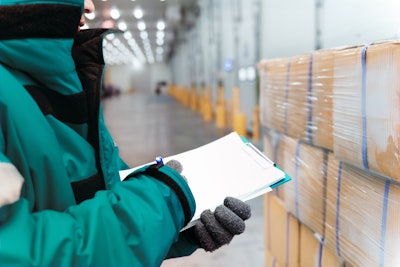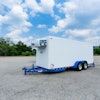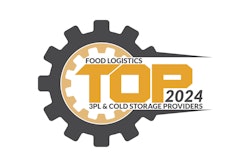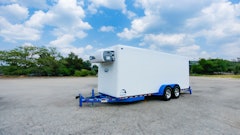
The cold storage sector continues to boom as a result of the rise in e-commerce adoption by consumers, specifically around the use of online grocery platforms. This boom has accelerated demand for cold storage, which has significantly outpaced the modest 3.73 billion cubic feet of existing supply, much of which is dated product built nearly 40 years ago. Recent increases in construction have also been tempered by a slow capital markets landscape for commercial real estate.
Adding to the sector’s significant inventory challenges is the specialized nature of developing cold storage facilities, coupled with high construction costs, interest rates, lead times and supply chain backlogs. This, along with a significant number of outdated and obsolete facilities requiring retrofitting, it is little wonder that tenants are frustrated with current market conditions.
The challenges: high demand, limited inventory, very expensive
The shift in consumer behavior that is accelerating cold storage demand has caught the attention of investors, real estate investment trusts (REITS) and developers who are now active players in the market, snatching up product as soon as it becomes available and/or developing speculative buildings in the hopes of capitalizing on high demand by cold storage users struggling to find adequate space.
This pent-up demand is forcing many users to turn to third-party logistic (3PLs) companies to support their cold storage needs. But as their companies grow so do their space requirements which is driving the recent uptick in build-to-suit developments across virtually every core market in the United States.
But building a cold storage facility takes time.
While retrofitting an older building can be accomplished within a 12-month timeframe, a typical greenfield development takes roughly two years to complete. However, before that can even happen, finding a suitable location for the facility, which ideally should be near densely populated areas where demand is highest and have easy access to major transportation arteries, is an added challenge as land in such areas is often limited.
Then there is the cost and highly specific design features.
Once a suitable location is secured, building a cold storage facility is a much more complex and costly process compared to a standard warehouse. These specialized facilities require significant financial investment and have considerably higher upfront costs to outfit the infrastructure with the necessary features and equipment to operate effectively.
Today’s best-in-class cold storage facilities built on spec are typically 300,000 square feet and configured to be divisible between 70,000-200,000 square feet to support a variety of tenants such as regional or local manufacturing companies, food products and processing companies. Unlike a standard warehouse, cold storage facilities have cool docks at the front of the building that vary between 60-70 feet deep and have a clear height of 40 feet with ample trailer storage and dock doors.
Inside, these facilities have innovative features such as advanced refrigeration technologies and insulation that can cool various parts of the building at different temperatures, specific concrete flooring systems that can withstand extreme temperatures and thermal shock, as well as temperature sensors and monitoring devices to ensure efficient airflow and temperature distribution.
Investors and developers, though recognizing the growing demand for cold storage facilities, are having to carefully assess the risk associated with this type of investment. Not only because of the initial upfront costs, but also because it is a highly customized asset up for lease to a niche user. To mitigate the chance of vacancies, they must carefully balance rental rates to stay competitive while also managing to recoup construction costs.
Rates for new facilities in the cold storage sector range anywhere between $16-25 per square foot depending on region, with California and New Jersey boasting the highest rates.
The outlook: constrained and competitive
The challenges facing cold storage users are familiar to the overall U.S. industrial markets where, for several years demand has far outstripped supply. In the third quarter of this year, U.S. industrial saw a record 171.8 million square feet of construction completions, representing an 18.7% uptick quarter-over-quarter and a 10.4% increase compared to the previous record set in Q3 2022.
Since the start of the year, more than 451 million square feet of new deliveries have been completed across the nation, 23.5% higher compared to this time last year. The south region continues to outpace the nation, accounting for 47% of the year-to-date deliveries, representing 34.4% of the nationwide inventory.
Specific to the cold storage sector, the outlook remains much the same as what is playing out in the market today with no real sign of relief for another couple of years. Nationwide, 6.5 million square feet of space is under construction as of Q3 2023. Currently, the Southeast U.S. has a significant portion of projects in the pipeline, totaling 4.3 million square feet slated for completion by 2025, followed by the Northeast and Midwest at 900,000 square feet each however, much of this inventory has already been pre-leased, with national vacancy in the sector below 4% as of Q3 2023
While only representing 1.7%, or 289 million square feet, of the entire industrial market which consists of 17.1 billion square feet nationally, this specialized market will continue to be a vital part of the industry and remain constrained as e-commerce and the convenience of online grocery shopping continues to gain traction and the time-intensive nature of constructing cold storage facilities persists.
Navigate with expertise
To effectively navigate the challenges and opportunities in this highly specialized sector, occupiers and investors alike should start to plan at least two years ahead and leverage the expertise of commercial real estate brokers whose deep knowledge and insights of local and national real estate markets can save time in helping to identify potential sites and availability.
Additionally, having access to real estate expertise and practices, including zoning regulations, land acquisition, property development, and site selection tailored specifically to cold storage requirements as well as understanding the drivers of demand, trends, and market gaps is critical for making informed investment decisions, developing strategies, and mitigating risk to address future needs.
With the ongoing evolution of e-commerce, increasing demand, and scarcity of inventory, the cold storage real estate sector must remain agile and responsive to future market demands. Whether you’re an occupier or an investor looking for cold storage space, it is both prudent and recommended to plan well ahead of anticipated needs and work with professionals knowledgeable in this specific sector to garner the best outcomes to meet long-term requirements.


















